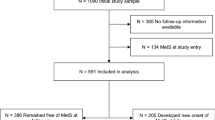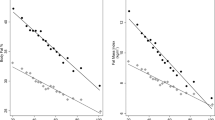Abstract
Background:
Regular physical activity (PA), a high level of fitness and a high diet quality are positively associated with health. However, information about stability of fitness components and diet quality indices is limited. This study aimed to evaluate stability of those parameters.
Methods:
This study includes 652 adults (men=57.56 (10.28) years; women=55.90 (8.34) years at follow-up) who participated in 2002–2004 and returned for follow-up at the Policy Research Centre Leuven in 2012–2014. Minutes sport per day and Physical activity level (PAL) were calculated from the Flemish Physical Activity Computerized Questionnaire. Cardiorespiratory fitness (CRF), morphological fitness (MORF; body mass index and waist circumference) and metabolic fitness (METF) (blood cholesterol and triglycerides) were used as fitness components. Diet quality indices (Healthy Eating Index-2010 (HEI), Diet Quality Index (DQI), Mediterranean Diet Score (MDS)) were calculated from a diet record. Tracking coefficients were calculated using Pearson/Spearman correlation coefficients (rPearson) and intra-class correlation coefficients (rICC).
Results:
In both men (rPearson&ICC=0.51) and women (rPearson=0.62 and rICC=0.60) PAL showed good stability, while minutes sport remained stable in women (rPearson&ICC=0.57) but less in men (rPearson&ICC=0.45). Most fitness components remained stable (r⩾0.50) except some METF components in women. In general the diet quality indices and their components were unstable (r<0.50).
Conclusions:
PAL and the majority of the fitness components remained stable, while diet quality was unstable over 10 years. For unstable parameters such as diet quality measurements are needed at both time points in prospective research.
This is a preview of subscription content, access via your institution
Access options
Subscribe to this journal
Receive 12 print issues and online access
$259.00 per year
only $21.58 per issue
Buy this article
- Purchase on Springer Link
- Instant access to full article PDF
Prices may be subject to local taxes which are calculated during checkout
Similar content being viewed by others
References
Warburton DE, Bredin SS . Reflections on physical activity and health: what should we recommend? Can J Cardiol 2016; 32: 495–504.
Lee DC, Artero EG, Sui X, Blair SN . Mortality trends in the general population: the importance of cardiorespiratory fitness. J Psychopharmacol 2010; 24: 27–35.
Mandviwala T, Khalid U, Deswal A . Obesity and cardiovascular disease: a risk factor or a risk marker? Curr Atheroscler Rep 2016; 18: 21.
Stone NJ, Robinson JG, Lichtenstein AH, Bairey Merz CN, Blum CB, Eckel RH et al. 2013 ACC/AHA guideline on the treatment of blood cholesterol to reduce atherosclerotic cardiovascular risk in adults: a report of the American College of Cardiology/American Heart Association Task Force on Practice Guidelines. Circulation 2014; 129: S1–S45.
Willett WC, Stampfer MJ . Current evidence on healthy eating. Annu Rev Public Health 2013; 34: 77–95.
Kant AK . Indexes of overall diet quality: a review. J Am Diet Assoc 1996; 96: 785–791.
Alkerwi A . Diet quality concept. Nutrition 2014; 30: 613–618.
Wirt A, Collins CE . Diet quality—what is it and does it matter? Public Health Nutr 2009; 12: 2473–2492.
Telama R, Yang X, Viikari J, Valimaki I, Wanne O, Raitakari O . Physical activity from childhood to adulthood: a 21-year tracking study. Am J Prevent Med 2005; 28: 267–273.
Parsons TJ, Power C, Manor O . Longitudinal physical activity and diet patterns in the 1958 British Birth Cohort. Med Sci Sports Exerc 2006; 38: 547–554.
Anderssen N, Jacobs DR Jr., Sidney S, Bild DE, Sternfeld B, Slattery ML et al. Change and secular trends in physical activity patterns in young adults: a seven-year longitudinal follow-up in the Coronary Artery Risk Development in Young Adults Study (CARDIA). Am J Epidemiol 1996; 143: 351–362.
Friedman HS, Martin LR, Tucker JS, Criqui MH, Kern ML, Reynolds CA . Stability of physical activity across the lifespan. J Health Psychol 2008; 13: 1092–1104.
Kirjonen J, Telama R, Luukkonen R, Kaaria S, Kaila-Kangas L, Leino-Arjas P . Stability and prediction of physical activity in 5-, 10-, and 28-year follow-up studies among industrial employees. Scand J Med Sci Sports 2006; 16: 201–208.
Sallis JF, Greenlee L, McKenzie TL, Broyles SL, Zive MM, Berry CC et al. Changes and tracking of physical activity across seven years in Mexican-American and European-American mothers. Women Health 2001; 34: 1–14.
Mulder M, Ranchor AV, Sanderman R, Bouma J, van den Heuvel WJ . The stability of lifestyle behaviour. Int J Epidemiol 1998; 27: 199–207.
Armstrong GK, Morgan K . Stability and change in levels of habitual physical activity in later life. Age Ageing 1998; 27: 17–23.
Morseth B, Jorgensen L, Emaus N, Jacobsen BK, Wilsgaard T . Tracking of leisure time physical activity during 28 yr in adults: the Tromso study. Med Sci Sports Exerc 2011; 43: 1229–1234.
Cleland VJ, Ball K, Magnussen C, Dwyer T, Venn A . Socioeconomic position and the tracking of physical activity and cardiorespiratory fitness from childhood to adulthood. Am J Epidemiol 2009; 170: 1069–1077.
Matton L, Thomis M, Wijndaele K, Duvigneaud N, Beunen G, Claessens AL et al. Tracking of physical fitness and physical activity from youth to adulthood in females. Med Sci Sports Exerc 2006; 38: 1114–1120.
Boreham C, Robson PJ, Gallagher AM, Cran GW, Savage JM, Murray LJ . Tracking of physical activity, fitness, body composition and diet from adolescence to young adulthood: The Young Hearts Project, Northern Ireland. Int J Behav Nutr Phys Act 2004; 1: 14.
Soric M, Jembrek Gostovic M, Gostovic M, Hocevar M, Misigoj-Durakovic M . Tracking of BMI, fatness and cardiorespiratory fitness from adolescence to middle adulthood: the Zagreb Growth and Development Longitudinal Study. Ann Hum Biol 2014; 41: 238–243.
Newby PK, Hu FB, Rimm EB, Smith-Warner SA, Feskanich D, Sampson L et al. Reproducibility and validity of the Diet Quality Index Revised as assessed by use of a food-frequency questionnaire. Am J Clin Nutr 2003; 78: 941–949.
Kimokoti RW, Newby PK, Gona P, Zhu L, Campbell WR, D'Agostino RB et al. Stability of the Framingham nutritional risk score and its component nutrients over 8 years: the framingham nutrition studies. Eur J Clin Nutr 2012; 66: 336–344.
Bjornara HB, Hillesund ER, Torstveit MK, Stea TH, Overby NC, Bere E . An assessment of the test-retest reliability of the New Nordic Diet score. Food Nutr Res 2015; 59: 28397.
McCullough ML, Feskanich D, Stampfer MJ, Giovannucci EL, Rimm EB, Hu FB et al. Diet quality and major chronic disease risk in men and women: moving toward improved dietary guidance. Am J Clin Nutr 2002; 76: 1261–1271.
Duvigneaud N, Wijndaele K, Matton L, Deriemaeker P, Philippaerts R, Lefevre J et al. Socio-economic and lifestyle factors associated with overweight in Flemish adult men and women. BMC Public Health 2007; 7: 23.
Matton L, Wijndaele K, Duvigneaud N, Duquet W, Philippaerts R, Thomis M et al. Reliability and validity of the Flemish Physical Activity Computerized Questionnaire in adults. Res Q Exerc Sport 2007; 78: 293–306.
Mertens E, Deforche B, Mullie P, Lefevre J, Charlier R, Knaeps S et al. Longitudinal study on the association between three dietary indices, anthropometric parameters and blood lipids. Nutr Metab 2015; 12: 47.
Deriemaeker P, Aerenhouts D, Hebbelinck M, Clarys P . Validation of a 3-Day Diet Diary: Comparison with a 7-Day Diet Diary and a FFQ. Med Sci Sports Exerc 2006; 38: S328–S328.
Bloom BS . Stability and Change in Human Characteristics. Wiley: New York, NY, USA, 1964.
Cohen J . Statistical Power Analysis for the Behavioral Sciences. 2nd edn. Lawrence Erlbaum: New Jersey, USA, 1988.
Craigie AM, Lake AA, Kelly SA, Adamson AJ, Mathers JC . Tracking of obesity-related behaviours from childhood to adulthood: a systematic review. Maturitas 2011; 70: 266–284.
Mota J, Guerra S, Leandro C, Pinto A, Ribeiro JC, Duarte JA . Association of maturation, sex, and body fat in cardiorespiratory fitness. Am J Hum Biol 2002; 14: 707–712.
Sallis JF, Prochaska JJ, Taylor WC . A review of correlates of physical activity of children and adolescents. Med Sci Sports Exerc 2000; 32: 963–975.
Bertheke Post G, de Vente W, Kemper HC, Twisk JW . Longitudinal trends in and tracking of energy and nutrient intake over 20 years in a Dutch cohort of men and women between 13 and 33 years of age: The Amsterdam growth and health longitudinal study. Br J Nutr 2001; 85: 375–385.
Ryan RM, Deci EL . Self-determination theory and the facilitation of intrinsic motivation, social development, and well-being. Am Psychol 2000; 55: 68–78.
Wetter AC, Goldberg JP, King AC, Sigman-Grant M, Baer R, Crayton E et al. How and why do individuals make food and physical activity choices? Nutr Rev 2001; 59: S11–S20.
Acknowledgements
The authors are indebted to the participants in this study. This research has been carried out by the Policy Research Centre Sport, which is funded by the Flemish government.
Author information
Authors and Affiliations
Corresponding author
Ethics declarations
Competing interests
The authors declare no conflict of interest.
Rights and permissions
About this article
Cite this article
Mertens, E., Clarys, P., Mullie, P. et al. Stability of physical activity, fitness components and diet quality indices. Eur J Clin Nutr 71, 519–524 (2017). https://doi.org/10.1038/ejcn.2016.172
Received:
Revised:
Accepted:
Published:
Issue Date:
DOI: https://doi.org/10.1038/ejcn.2016.172
This article is cited by
-
Longitudinal associations between physical activity and five risk factors of metabolic syndrome in middle-aged adults in Germany
Diabetology & Metabolic Syndrome (2023)
-
Changes in diet from pregnancy to one year after birth: a longitudinal study
BMC Pregnancy and Childbirth (2021)
-
Obesity, walking pace and risk of severe COVID-19 and mortality: analysis of UK Biobank
International Journal of Obesity (2021)
-
Diet quality and cognitive function in mid-aged and older men and women
BMC Geriatrics (2019)
-
What is the relationship between physical fitness level and macro- and micronutrient intake in Spanish older adults?
European Journal of Nutrition (2019)



